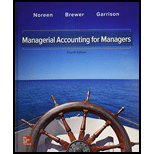
1.
Introduction:
Break-even point:
Break-even point is defined as the volume of production where the total cost is equal to the total sales revenue generated thereby resulting in a no-
To calculate: The variable expenses per unit.
2.
Introduction:
Break-even point:
Break-even point is defined as the volume of production where the total cost is equal to the total sales revenue generated thereby resulting in a no-profit and no loss situation. At the break-even point, the contribution earned is sufficient to cover the costs, whereas if the contribution is less than the break-even point then it is a loss and if it is more, then it is a profit.
To calculate: The break-even point in unit sales and dollar sales.
3.
Introduction:
Break-even point:
Break-even point is defined as the volume of production where the total cost is equal to the total sales revenue generated thereby resulting in a no-profit and no loss situation. At the break-even point, the contribution earned is sufficient to cover the costs, whereas if the contribution is less than the break-even point then it is a loss and if it is more, then it is a profit.
To calculate: The required amount of unit sales and dollar sales is required to achieve a target profit of $60000 per year.
4.
Introduction:
Break-even point:
Break-even point is defined as the volume of production where the total cost is equal to the total sales revenue generated thereby resulting in a no-profit and no loss situation. At the break-even point, the contribution earned is sufficient to cover the costs, whereas if the contribution is less than the break-even point then it is a loss and if it is more, then it is a profit.
To calculate: Company’s new break-even point in unit sales and in dollar sales upon assuming that if it uses a more efficient shipper and able to reduce variable expenses by $4 per unit. The dollar sales that is required to attain a target profit of $60000.
Want to see the full answer?
Check out a sample textbook solution
Chapter 3 Solutions
GEN COMBO MANAGERIAL ACCOUNTING FOR MANAGERS; CONNECT 1S ACCESS CARD
- I need assistance with this general accounting question using appropriate principles.arrow_forwardCan you explain this financial accounting question using accurate calculation methods?arrow_forwardCan you help me solve this financial accounting question using valid financial accounting techniques?arrow_forward
- Please provide the accurate answer to this financial accounting problem using appropriate methods.arrow_forwardPlease provide the solution to this general accounting question using proper accounting principles.arrow_forwardI need help finding the accurate solution to this general accounting problem with valid methods.arrow_forward
- Determine the price of a $1.3 million bond issue under each of the following independent assumptions: Maturity 10 years, interest paid annually, stated rate 8%, effective (market) rate 10%. Maturity 10 years, interest paid semiannually, stated rate 8%, effective (market) rate 10%. Maturity 10 years, interest paid semiannually, stated rate 10%, effective (market) rate 8%. Maturity 20 years, interest paid semiannually, stated rate 10%, effective (market) rate 8%. Maturity 20 years, interest paid semiannually, stated rate 10%, effective (market) rate 10%.arrow_forwardIf total assets increase while liabilities remain unchanged, equity must: A) IncreaseB) DecreaseC) Remain the sameD) Be negativearrow_forwardNo chatgpt!! Which of the following is an intangible asset? A) InventoryB) CopyrightC) EquipmentD) Accounts Receivablearrow_forward

 AccountingAccountingISBN:9781337272094Author:WARREN, Carl S., Reeve, James M., Duchac, Jonathan E.Publisher:Cengage Learning,
AccountingAccountingISBN:9781337272094Author:WARREN, Carl S., Reeve, James M., Duchac, Jonathan E.Publisher:Cengage Learning, Accounting Information SystemsAccountingISBN:9781337619202Author:Hall, James A.Publisher:Cengage Learning,
Accounting Information SystemsAccountingISBN:9781337619202Author:Hall, James A.Publisher:Cengage Learning, Horngren's Cost Accounting: A Managerial Emphasis...AccountingISBN:9780134475585Author:Srikant M. Datar, Madhav V. RajanPublisher:PEARSON
Horngren's Cost Accounting: A Managerial Emphasis...AccountingISBN:9780134475585Author:Srikant M. Datar, Madhav V. RajanPublisher:PEARSON Intermediate AccountingAccountingISBN:9781259722660Author:J. David Spiceland, Mark W. Nelson, Wayne M ThomasPublisher:McGraw-Hill Education
Intermediate AccountingAccountingISBN:9781259722660Author:J. David Spiceland, Mark W. Nelson, Wayne M ThomasPublisher:McGraw-Hill Education Financial and Managerial AccountingAccountingISBN:9781259726705Author:John J Wild, Ken W. Shaw, Barbara Chiappetta Fundamental Accounting PrinciplesPublisher:McGraw-Hill Education
Financial and Managerial AccountingAccountingISBN:9781259726705Author:John J Wild, Ken W. Shaw, Barbara Chiappetta Fundamental Accounting PrinciplesPublisher:McGraw-Hill Education





